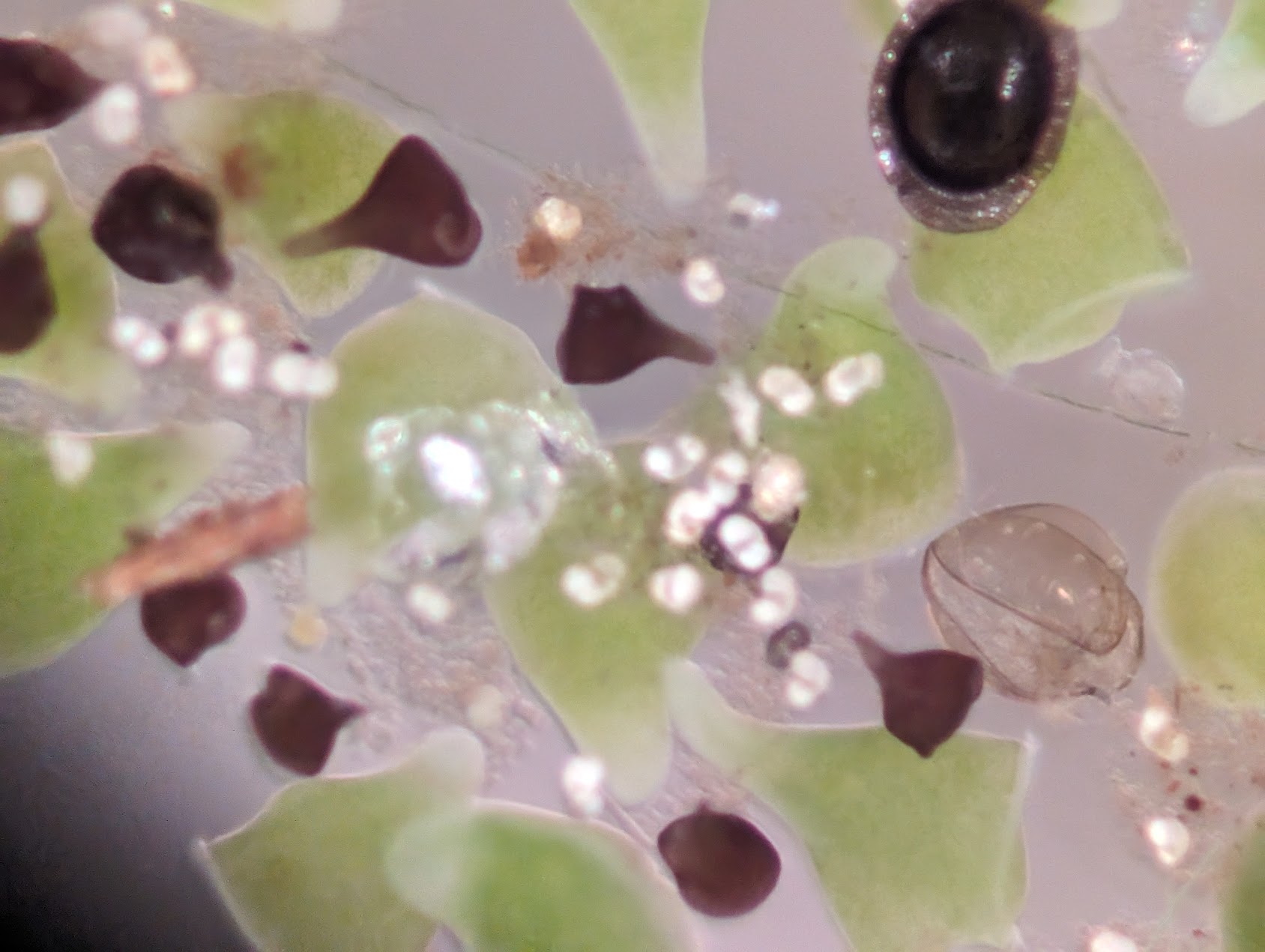Cortes Lab @Virginia Tech | Unite to Divide
Research
I - Stentor Research Questions

Overview
Stentor are large heterotrich ciliates that are found all across the world in nearly every type of fresh water environment. Despite being unicellular, Stentor can grow as large as 2-3 millimeters, making these organisms large enough to see with the naked eye. Furthermore, these single-cell organisms exhibit strikingly complex behaviors and are capable of non-associative learning, hierarchical decision-making, food selectivity, and much more. Stentor are also morphologically very complex, containing spatially diverse cellular structures including their oral structures along their frontal field, their macronuclear node(s), and their holdfast at their posterior end.
Significance
Complex unicellular organisms like Stentor provide a unique opportunity to study the molecular and cellular mechanisms behind organismal behavior and other organismal processes like wound-healing and regeneration. Because the organism is a single cell, Stentor cellular processes directly result in the complex behaviors and processes of the organism. As an example, multicellular organisms generally rely on complex multicellular systems to maintain homeostasis and adapt to their ever-changing natural habitats. In order to thrive in aquatic ecosystems Stentor must also be equipped to adapt to the environmental changes that occur throughout the day and throughout the seasons. Unlike multicellular organisms, however, the Stentor cell must rely entirely on its own internal cellular systems in order to adapt and maintain its proper function. Our lab uses a combination of cell biology, genetics, molecular biology, biophysics, and computer vision to address questions about how the complex behaviors and organismal processes of the Stentor cell arise. We are interested in a wide range of questions.
Projects
1) Do Stentor possess a circadian clock, and if so what are its core components?
Stentor species feature a wide range of methods for detecting light and interacting with their environments. This includes species like S. coeruleus which has a photopigment stentorin that it uses to detect and turn away from bright light, S. pyriformis which has endosymbiotic algae that it uses to detect and swim directly towards bright light, S. stipatus which has both a photopigment and endosymbiotic algae and generally swims towards bright light, S. polymorphus which has non-obligate endosymbiotic algae that it uses to swim weakly towards bright light, and S. muelleri which is not known to contain any light detectors and exhibits no phototaxis.
Preliminary data shows that several Stentor species are more likely to undergo cell division at night and exhibit stronger phototaxis during the day. These observations suggest that Stentor, like other Ciliates, may have a circadian clock that regulates key cell behaviors. Our lab is currently exploring this potential via a combination of genomics (sequencing Stentor genomes), cell biology, and biochemistry.
2) How do stentor make hierarchical decisions?
Stentor roeselii has been demonstrated to exhibit a hierarchical decision tree of avoidance behaviors when presented with a noxious stimulant. Our lab has recently demonstrated that most (or all) stentor species exhibit some variation of this hierarchical decision tree. Using careful control of noxious substance delivery in different stentor species, we aim to define a model that predicts stentor hierarchical decision-making. In the long-term, we will incorporate genetic manipulation to dissect the molecular pathways that affect and enact this hierarchical decision tree.

3) How does Stentor pyriformis move towards light?
Stentor pyriformis phototaxis is dependent on the endosymbiotic algae within it. We seek to describe how the algae modulates stentor behavior to make it turn towards bright white light with such efficacy. We are currently exploring particle image velocimetry (PIV) methods to describe changes in ciliary beating and flow patterns around the stentor cell body in response to asymmetric light source. In the long-term we will explore the genetic and molecular pathways that enable the algae within the stentor to make it turn towards white light.
4) How do Stentor divide?

Stentor cell division, the primary mechanism by which Stentor reproduce, is a complex cellular event that requires careful orchestration of several processes. The macronuclear content of the cell undergoes significant restructuring and redistribution, while at the same time the cell begins to undergo constriction near its middle along the anterior-posterior axis. A new oral apparatus begins to form at the zone of contrast and migrates towards the top of the posterior daughter while the bottom of the anterior daughter begins to form a new holdfast in the region around the constriction. This leads to late dividing Stentor cells looking as if one cell is attempting to ingest the other.
Most of what we know about Stentor cell division comes from early research before fluorescent markers were available. Thus, it remains unknown how constriction occurs in this organism. Stentor have actin and several myosin-like proteins, suggesting the potential for an actomyosin contractile ring. Our lab is using cell biology, genetics, and genomics approaches to decipher how constriction of the Stentor cell occurs during division.

Early division of a Stentor cell. Actin, visible in cyan, appears to concentrate at the site of constriction, though no visible 'ring' forms.

Slightly later along in division of a Stentor cell, now showing the maturing oral apparatus moving toward the site of constriction where the posterior daughter cell will split off and form a 'mouth.' Actin, visible in green, appears concentrated near the posterior end of the anterior daughter. Tubulin, visible in red, shows no redistribution.

II- C. elegans Research Questions
Overview
Cytokinesis is a cellular process occurring during cell division, by which a mother cell divides into two daughter cells. During cytokinesis, duplicated chromosomes must accurately segregate apart into forming cells. At the same time, an actomyosin contractile ring assembles at the cortex between segregating chromosome masses. The contractile ring constricts circumferentially, resulting in radial shrinkage which drives plasma membrane invagination. This active constriction must be coordinated with chromosome segregation to ensure proper cell division and proper genomic fidelity. We use a combination of genetics, microscopy, and computer modeling to study the processes of cell division within the zygotic and female meiotic divisions of the nematode Caenorhabditis elegans.
Significance
Failure of cytokinesis can result in aneuploidy. If aneuploid cells continue dividing they can accrue further chromosomal defects and result in organism-wide diseases or disorders, including cancer.
Projects
1) How does contractile ring composition affect constriction?

As the contractile ring constricts, it undergoes a drastic reduction in overall size. How contractile ring composition changes as it changes in size and shape likely plays a role in force generation and overall contractility. We employ a combination of quantitative microscopy along with 3-dimensional molecular models of cytokinesis to tease apart the effects of the dynamic composition of the contractile ring.
2) How do chromosomes and the contractile ring communicate?


Other model systems have exhibited a checkpoint that prevents cell division when chromosome bridges occur in anaphase. This abscission checkpoint is believed to depend on the function of several proteins, including Aurora B kinase, Vps4, and ESCRT-III machinery. Aurora B is believed to phosphorylate other proteins in the presence of persistent chromosome bridges, and thereby recruit active ESCRT-III component, CHMP4C to inhibit abscission. We use a combination of genetics and microscopy to investigate whether this checkpoint is also present in C. elegans. We are also interested in exploring other potential mechanisms by which chromosome mis-segregation may trigger changes to the dynamics of cytokinesis, including potential effects on contractile ring composition.

